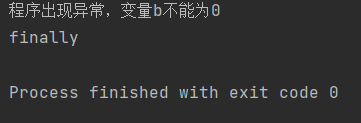异常
1、try监控区域 , catch捕获异常 , finally处理善后工作 , throw和throws抛出异常。
2、catch可以写多个,最大的异常必须写在最后面,从小到大。
3、try和catch必须使用,finally可以不使用。
4、快捷键: Ctrl + alt + t
5、在方法上是throws 抛出异常, 在方法里是throw。
例1:
1 public class Demo1 { 2 public static void main(String[] args) { 3 int a = 1; 4 int b = 0; 5 System.out.println(a/b); 6 } 7 }
这个代码会出现异常!

我们通过编译后的异常写入代码中
1 public class Demo1 { 2 public static void main(String[] args) { 3 int a = 1; 4 int b = 0; 5 6 //try监控区域 7 //try 和 catch必须使用, finally可以不使用。 8 try { 9 System.out.println(a/b); 10 //catch 捕获异常, catch(想要捕获的异常类型) 11 //catch 可以写多个, 最大的异常必须写在最后面,从小到大 12 }catch(ArithmeticException e){ 13 System.out.println("程序出现异常,变量b不能为0"); 14 //处理善后工作 15 }finally{ 16 System.out.println("finally"); 17 } 18 } 19 }
编译后结果

例2:
写多个catch,从小到大,不能乱写不然要报错!
1 public class Demo1 { 2 public static void main(String[] args) { 3 int a = 1; 4 int b = 0; 5 6 //try监控区域 7 //try 和 catch必须使用, finally可以不使用。 8 try { 9 System.out.println(a/b); 10 //catch 捕获异常, catch(想要捕获的异常类型) 11 //catch 可以写多个, 最大的异常必须写在最后面,从小到大 12 }catch(Error e){ 13 System.out.println("Error"); 14 } 15 catch(Exception e){ 16 System.out.println("Exception"); 17 //处理善后工作 18 }catch (Throwable e){ 19 System.out.println("Throwable"); 20 } 21 finally{ 22 System.out.println("finally"); 23 } 24 } 25 }





 浙公网安备 33010602011771号
浙公网安备 33010602011771号